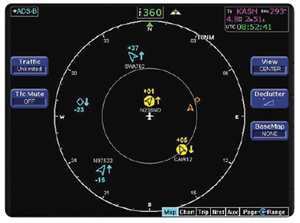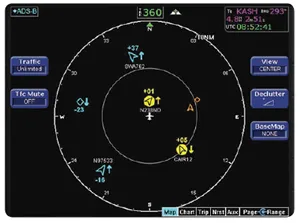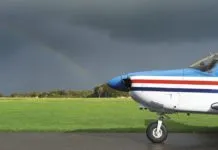
300
A recent discussion with a friend who happens to be an aviation attorney got me thinking about how pilots put too much faith in cockpit traffic alert systems. Without spilling the beans on privileged client/attorney speak, he spoke of a lawsuit he was working that arose from an ugly mid-air collision involving an aircraft well-equipped with high-end traffic alerting gear. It’s the type of accident provoking lots of emotion since it sadly took some lives. From what I could gather, there were some fingers wrongly pointed at the traffic system manufacturer, as if the traffic system failed at its intended job.
This discussion did little to cure my own personal phobia of mid-air collisions. As a technician involved with traffic system installs for more years than I can remember, it confirmed what I knew all along: Traffic alerters aren’t a foolproof substitute for the eyeballs that should be looking outside the aircraft whenever possible. Here’s why.
Know thy technology
Every pilot flying behind a traffic alert system needs to understand the theory behind the system installed in a given aircraft. This should also include its limitations. Lack of understanding is a setup for incorrect use and interpretation of the traffic targets being painted on the screen.
First and foremost is understanding the acronyms and the different systems out there. The most misunderstood abbreviations are TCAS and TAS, which aren’t the same. The system known as TCAS—traffic collision avoidance system or traffic alert and collision avoidance system—is often and incorrectly used as a general term to describe any on-board traffic annunciator. The TCAS I technology was perhaps the first of its kind and appeared in smaller transport-category machines, eventually being mandated for aircraft with 10 to 30 passenger seats. It was developed to accommodate the upper end of general aviation applications and the operations of regional airline equipment. It offers traffic advisories (TAs) to help with visual acquisition of the threat target—the main theory of awareness that’s trickled down to all other traffic alerters.
Meanwhile, TCAS II takes the technology to a higher level, analyzing the projected flight path of a threat target and issuing resolution advisories, or RAs. It’s arguably the best traffic gear available and works by actively interrogating other Mode A, C and S transponder systems. Much like an ATC radar interrogation, it then listens for a target reply and calculates as much distance, relative bearing, altitude and vertical trend information as possible. The TCAS II technology is required worldwide in aircraft with more than 30 seats.
The traffic awareness system, TAS, on the other hand, is the scaled-back system more commonly found in the smaller not-for-transport aircraft we fly. The theory behind TAS is much like that of TCAS, with some critical and limiting differences. For example, TAS actively interrogates other Mode A, C and S transponder systems and any alerts generated rely completely on those responses. Much like an ATC radar interrogation, TAS systems listen for a target reply and then calculate as much of distance, relative bearing, altitude and vertical trend as possible. The core difference between a full-up TCAS system and TAS is that TAS won’t offer resolution advisories.
But a TAS system’s ultimate functionality is to process potentially conflicting traffic and calculate a closure rate to the interrogating host aircraft. Closure rate processing is known as the closest point of approach (CPA) and calculation of a collision course triggers an audible and pictorial traffic alert using on-screen symbology. This on-screen symbology of circles, diamonds and appropriate color-coding has trickled down from TCAS. With TAS, once that alert is issued, your immediate action should be acquiring the traffic with your eyes. The system won’t tell you where to maneuver to avoid the threat. Only TCAS II can do that, via its RA-generation capability.
The bugaboo—if you’ve been in the TA hot seat enough—is that the traffic target that’s ultimately acquired visually isn’t always where the system paints it on the screen. There could be many reasons for this.
The Frequency Problem
Because TAS systems, transponder systems and DME systems operate on the same 1090 MHz frequency (they use independent antennas, an issue I’ll get to shortly), cross interference from co-installed systems is a real problem and challenge to the installer. Pulse interference usually limits the system’s ability to acquire targets that are farther away or fail to give accurate bearing information. Mutual suppression is a synchronous pulse that’s transmitted across systems to help suppress the transmission of the competing system.
I’ve seen many short-changed installations where this suppression wasn’t doing the job, and the system intermittently painted its own ship as a threat target. While startling at first—especially for paranoid traffic-phobes like me—it quickly becomes obvious that the traffic system is painting its own target. Technically, this phenomenon gets tricky and pulse theory comes into play. Some DMEs and transponders emit what’s called continuous wave, which can strangle low-level signals required to paint targets at greater distances.
The other nag is the issue of frequency congestion that exists on the 1090 MHz frequency band in congested airspace. Technical Standard Order (TSO) C147, which partly governs TAS system operating specs, calls for specific unattenuated peak interrogation power outputs and most systems are smart enough to reduce their transmit power and distance scanning when playing in airspace that’s overly congested. This helps with frequency congestion and overload.
It’s all about antennas
It was around 1997 when B.F. Goodrich brought its Skywatch TAS system to the market. It’s an accurate and reliable system that remains in the L-3 Avionics Systems product line today but still utilizes a single, top-mounted antenna that’s stirred some controversy about its ability to overcome the “shadowing” effect. That is, missing traffic targets that are being sheltered by the airframe.
I asked Garmin engineers what they thought of a dual antenna system versus that of a system saddled to a single directional antenna. Hands down, they recommend the optional bottom-mounted, L-band monopole, omni-directional antenna for aircraft equipped with fixed landing gear. For retracts, they recommend an optional bottom-mount directional antenna. These directional antennas on the bottom of the airframe, they say, help battle the shading of target aircraft flying above the host aircraft.
But even best-of-the-best antenna configuration may not ensure flawless performance. Fitting TAS antennas on the average light aircraft can be a huge challenge. That’s because specific guidelines are in place that govern antenna placement, in favor of reliable performance. Consider that the top-mounted directional antenna must be mounted as far forward and as close to the centerline of the airframe as possible, and it must be installed so that the horizontal base falls within a specific longitudinal and latitudinal axis while the aircraft sits in level flight.
More challenging yet is that the antenna may require nearly two feet of clearance from the others. In an age where we’ve littered our airframes with far more antennas than they were designed to carry, this can be a leading cause of poor TAS system performance.
Antenna installations on composite airframes pose a unique challenge because of limiting ground planes. The same is true of fabric construction. These installations will carry a premium in cost due to the extra effort and expertise required to work with the structure.
Which system, which mission
When it comes to selecting higher-end traffic systems, owners often rely on the advice of the installing shop. There’s nothing wrong with this approach and your shop should know which system is the most appropriate for your aircraft. Factors such as available space to accommodate the remote processor, antenna considerations, system integration and regulatory certification matters all come into play.
But it can be confusing, based on specs alone. For instance, Avidyne offers a sizeable list of available traffic systems in their TAS600-series active traffic minders. The TAS600 was born from the Ryan TCAD 9900 series before Avidyne merged with Ryan and took over the technology. Avidyne offers multiple tiers of processors, depending on the aircraft in which it’s installed.
For instance, the entry-level TAS-600 is geared toward basic single-engine and lower performance aircraft, given its limited range of only seven miles and 18,500-foot ceiling. The flagship TAS620, however, ups the ante to 21 miles and 55,000 feet worth of surveillance. There are several systems in between appropriate for mid-performance machines.
Similarly, Garmin’s GTS800-series active system, which also has ADS-B inpuut capability (when connected to a GTX330ES transponder), is offered in multiple flavors and antenna configurations, based on desired performance. The entry-level GTS800 has a 12-mile surveillance range. On the GTS820 and grander 850 system, a remotely-installed amplifier ups that range to 40 miles. Incidentally, the flagship GTS850 is actually certified as TCAS l and uses an official TCAS I antenna.
It’s important to match the processor to the aircraft. Obviously, a system with scaled-down range and service ceiling may be perfectly fine for a Skylane but not enough for a speedy turboprop. A qualified shop should be versed in what system is right for your aircraft.
What about TIS-B datalink?
By far the most popular traffic so lution flying around for lower-end aircraft is the traffic information system-broadcast, or TIS-B, received through a Mode S data link. The TIS-B system uses TCAS-like symbology and offers TA callouts through the audio system mimicking that of higher-end systems. But as good as TIS-B has proven to be, there are still some inherent limitations to know about. Most of the limitations relate to line-of-sight coverage.
Consider my home airport at Hartford, Conn., where there’s no TIS-B coverage at the traffic pattern altitude of around 1200 feet or lower. That’s because the secondary surveillance radar linking the data is located about 12 miles from Brainard Field. Every departure and initial climb for me is the same as my eyes anxiously watch the screen, waiting for traffic information to become valid.
The other issue that’s necessary to grasp while flying the TIS is the radar data stream’s inherent lag. Because there’s a slight delay in receiving and processing the target data, the azimuth and range of TIS-B targets is often latent and target jump is noticeable.
One day I decided to face my traffic phobia head on and observe the habits of TIS-B and TAS presenting the same traffic data on the screen. I launched into busy airspace in an aircraft equipped with both TIS-B and active TAS. What did I learn? One thing is TIS-B presents itself with obvious delay. The saving grace, however, is that TIS-B symbology offers a pictorial advantage because it uses ATC tracking data to draw a small vector line on the traffic tag, showing the general target direction. This can help with the disadvantage of target lag.
But one of the greatest advantages of TIS-B (other than a relatively low-cost buy-in) is the large surveillance capability. That’s because TIS-B reliably detects targets at greater range than active TAS, even though its display limitation usually is about seven miles. Remember, the painted targets are coming from ATC radar that looks across hundreds of square miles of airspace. You won’t find that kind of range from even the highest end active processor.
Putting it all together
No matter what traffic system you decide to have installed, it’s important not to skimp on the installation. An installation that’s lowballed with proportionally short-changed effort—whether it’s cutting corners on the antenna installation or not installing a bottom antenna in an airframe that’s prone to target shadowing—will do little for the system’s real world operation. Ask the shop how many systems they’ve installed in similar airframes, especially if yours is primarily made from composites.
If you are new to flying with any traffic system, you should expect a learning curve. In time, you’ll be able to recognize the system’s limitations and learn to better interpret what’s being painted on the screen. You also should train your eyes to be outside the aircraft as often as possible because a good set of watchful eyes is better than any traffic minder money can buy.
Larry Anglisano is the avionics editor at sister publication Aviation Consumer and an avionics Repairman. He’s seen more on-screen traffic than his traffic-phobic mind can handle.




